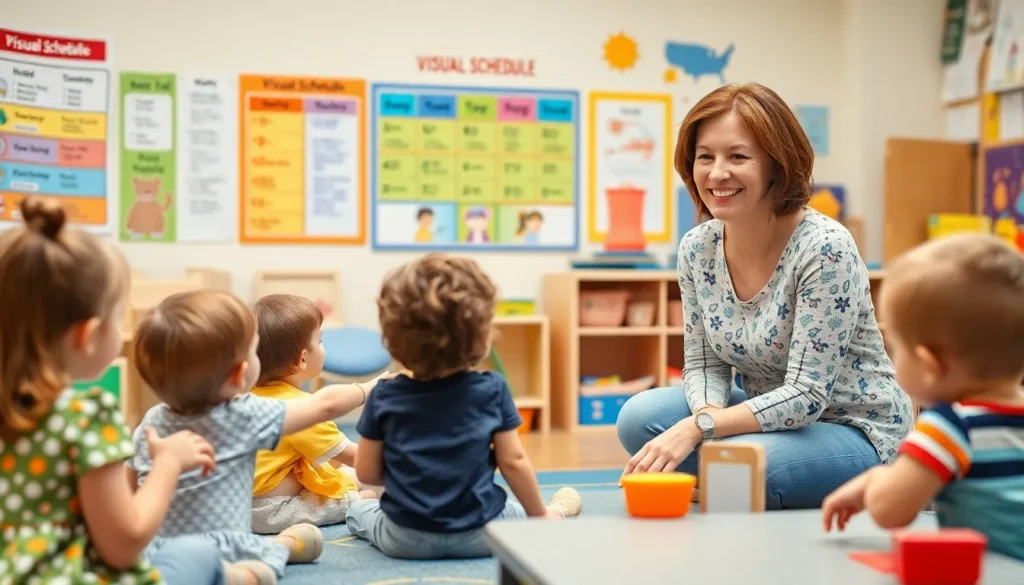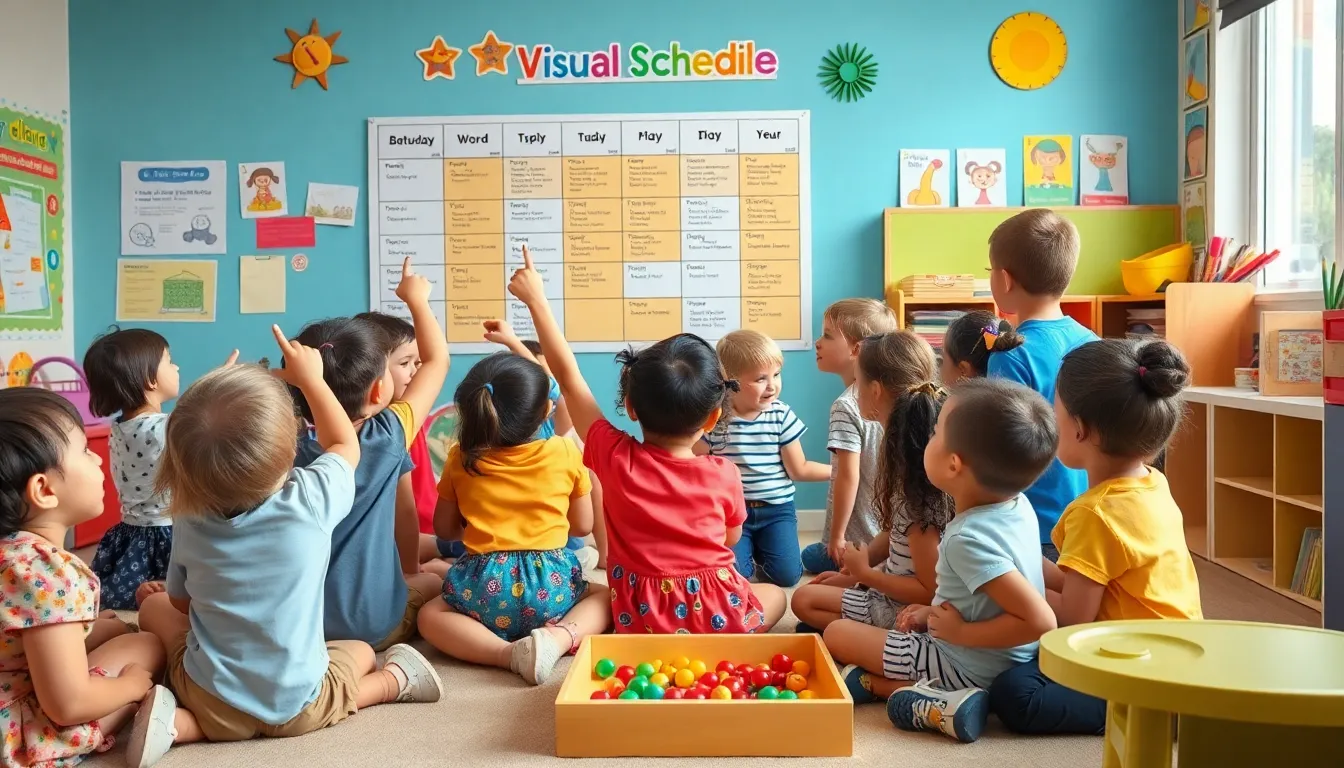Table of Contents
ToggleIn the bustling world of preschool, chaos is often just a crayon’s throw away. Enter visual schedules—your secret weapon against the daily whirlwind of tiny feet and even tinier attention spans. Imagine a magical chart that transforms confusion into clarity, helping little ones navigate their day like pros. With colorful pictures and simple words, these schedules make routines as easy as pie (or at least as easy as finger painting).
But it’s not just about keeping the peace; visual schedules can boost independence and confidence in young learners. They’ll know what’s coming next, reducing meltdowns and increasing smiles. So why not embrace the joy of organized fun? Dive into the world of visual schedules and discover how they can turn preschool pandemonium into a symphony of learning and laughter.
Overview Of Visual Schedules For Preschool
Visual schedules serve as effective tools in preschool environments. These schedules utilize images and symbols to represent daily activities. They help children grasp their routines, promoting familiarity and comfort. When children see what comes next, anxiety decreases and engagement increases.
Studies show that visual schedules can enhance independence among preschoolers. Children often experience improved decision-making when they can anticipate transitions. Clear structure aids in reducing distractions. Teachers and caregivers find that visual schedules minimize disruptions, creating smoother transitions throughout the day.
Additionally, these schedules cater to diverse learning styles. Visual learners, in particular, benefit from the concrete representation of tasks. They provide immediate feedback, allowing children to track their progress. For example, a child can see a completed task visually marked off the schedule, fostering a sense of accomplishment.
Incorporating visual schedules in classrooms also encourages social interaction. Children frequently discuss activities with peers, enhancing communication skills. Group discussions around the day’s schedule can spark collaboration, making learning more enjoyable.
Implementing visual schedules requires consistency and patience. Creating age-appropriate visuals tailored to the children’s needs strengthens understanding. It’s essential to regularly update schedules, reflecting any changes in daily routines. Frequent updates keep schedules relevant and engaging, ultimately boosting their effectiveness in preschool settings.
Benefits Of Using Visual Schedules
Visual schedules provide preschoolers with structure and understanding of their daily activities. These tools enhance the learning environment by promoting organization and clarity.
Enhancing Communication
Visual schedules facilitate communication among children and educators. They allow kids to express their needs and preferences clearly, nurturing language skills naturally. By discussing upcoming tasks or activities, children engage in conversations that encourage verbal expression. Daily routines outlined in visual formats help them share their thoughts and expectations with peers and teachers. This shared understanding fosters a supportive atmosphere where everyone feels included.
Supporting Independence
Visual schedules support children’s independence significantly. They empower preschoolers to track their activities autonomously. With a clear visual representation, children know what comes next, leading to less reliance on adults for direction. Kids gain confidence as they learn to manage their time and responsibilities. Anticipating transitions becomes easier, reducing anxiety and promoting a sense of control over their environment. The confidence cultivated through visual schedules sets a foundation for lifelong independence.
Types Of Visual Schedules
Visual schedules come in various forms, each catering to specific needs of preschoolers. Different types offer unique advantages, promoting understanding and independence.
Daily Schedule Boards
Daily schedule boards provide a clear overview of the day’s activities. They typically feature a sequence of images or symbols representing each task, such as circle time, snack, and play. By displaying this information visually, children can anticipate upcoming activities. Familiarity with their routines fosters a sense of security, helping to minimize anxiety during transitions. Daily schedule boards also reinforce independence, as children learn to refer back to the board to check what comes next, supporting their ability to manage time effectively.
First-Then Boards
First-then boards simplify immediate directives for preschoolers, clarifying task prioritization. Using this type of board, educators display two key elements: the “first” activity and the “then” activity. For example, a board might show “First, complete your artwork; then, play outside.” This structure creates a straightforward expectation, encouraging children to focus on completing initial tasks before moving on. First-then boards promote understanding of sequencing while strengthening patience and compliance. By breaking tasks into manageable chunks, they help reduce frustration and enhance children’s ability to follow directions.
How To Implement Visual Schedules
Implementing visual schedules involves a thoughtful approach to enhance children’s understanding of their routines. Effective visuals should be colorful and clear, incorporating images that align with each activity.
Creating Effective Visuals
Select images that represent activities accurately, such as using a picture of a snack for snack time or a book for reading time. Use large, engaging visuals that are easy for preschoolers to identify. Combine symbols with text where appropriate, ensuring that children associate words with their meanings. Regularly update visuals to reflect any changes in the schedule, keeping children engaged and informed. Ensure that materials are age-appropriate; using familiar characters or themes can enhance children’s connection to the visuals.
Tips For Consistent Use
Establish a routine for presenting visual schedules by introducing them during circle time each day. Consistency promotes familiarity, reducing anxiety about what comes next. Encourage children to interact with the schedule by pointing out activities they anticipate. Use positive reinforcement when they reference the schedule, so they associate it with success. Create opportunities for discussions about the schedule, allowing children to express preferences or concerns. Make adjustments based on observations, ensuring the schedule continues to meet their evolving needs.
Challenges And Solutions
Visual schedules in preschool settings face several challenges. One significant challenge involves children’s varying levels of understanding. Some preschoolers may struggle to interpret visuals, while others grasp them quickly. To address this, educators can provide examples, using familiar images that connect with each child’s experiences.
Another challenge relates to distractions within the classroom. Preschoolers often encounter interruptions that may confuse or derail their attention from the visual schedule. To mitigate this, teachers can establish a quiet space where children can refer to their schedules without interruptions, ensuring focus during transitions.
Keeping visuals updated poses a difficulty as well. Children outgrow certain activities or preferences, necessitating changes in the schedule. Regularly reviewing and adjusting visuals can engage children more, allowing them to remain interested and involved in their learning.
Implementing visual schedules requires consistency from educators, which can be a struggle in busy classrooms. To promote adherence, teachers can designate specific times during the day for schedule review, creating routine and familiarity. Moreover, incorporating group discussions about the schedule fosters a collaborative atmosphere, allowing children to express their feelings about upcoming activities.
Some children might resist the idea of following a visual schedule. They might prefer spontaneity over structure. Teachers can introduce the schedule gradually, making it a fun and interactive process. Positive reinforcement, such as praise and rewards, can encourage children to engage with their visual schedules.
Finally, diverse learning styles among preschoolers challenge the uniformity of a single visual schedule. Tailoring schedules for different learning preferences enhances accessibility for all. Combining various types of visuals, such as pictures, symbols, and text, meets individual needs while promoting inclusivity in the classroom.
Conclusion
Visual schedules are a powerful tool in preschool settings that transform chaotic routines into structured learning experiences. By fostering independence and enhancing communication skills, these schedules empower children to navigate their day with confidence. The engaging visuals not only cater to diverse learning styles but also create a sense of security and predictability.
As educators implement these schedules, they contribute to a supportive atmosphere where children can express their needs and preferences. Regular updates and interactive discussions ensure that visual schedules remain relevant and engaging. Ultimately, incorporating visual schedules into daily routines lays the groundwork for lifelong skills in time management and responsibility, making it an essential practice in early childhood education.








